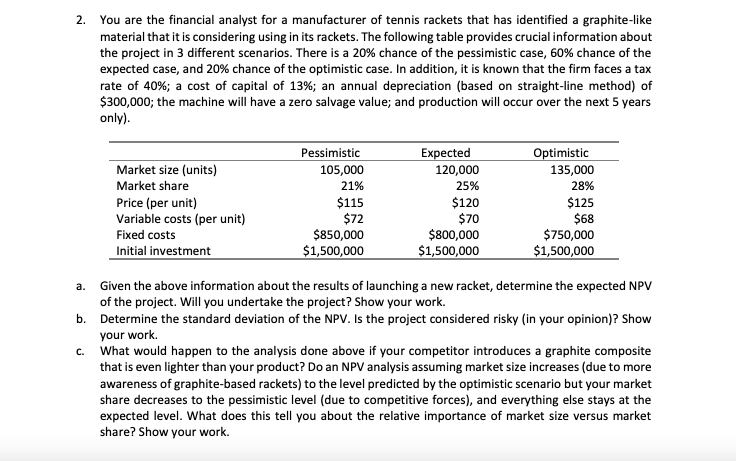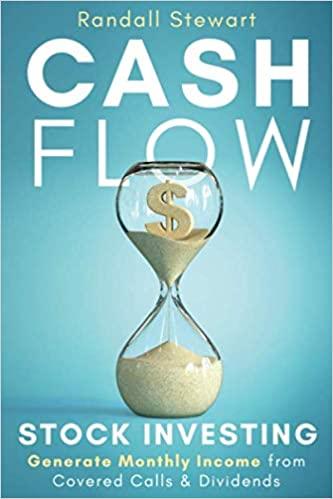Please explain this in detail and show all the work.

2. You are the financial analyst for a manufacturer of tennis rackets that has identified a graphite-like material that it is considering using in its rackets. The following table provides crucial information about the project in 3 different scenarios. There is a 20% chance of the pessimistic case, 60% chance of the expected case, and 20% chance of the optimistic case. In addition, it is known that the firm faces a tax rate of 40%; a cost of capital of 13%; an annual depreciation (based on straight-line method) of $300,000; the machine will have a zero salvage value; and production will occur over the next 5 years only). Market size (units) Market share Price (per unit) Variable costs (per unit) Fixed costs Initial investment Pessimistic 105,000 21% $115 $72 $850,000 $1,500,000 Expected 120,000 25% $120 $70 $800,000 $1,500,000 Optimistic 135,000 28% $125 $68 $750,000 $1,500,000 a. Given the above information about the results of launching a new racket, determine the expected NPV of the project. Will you undertake the project? Show your work. b. Determine the standard deviation of the NPV. Is the project considered risky (in your opinion)? Show your work c. What would happen to the analysis done above if your competitor introduces a graphite composite that is even lighter than your product? Do an NPV analysis assuming market size increases (due to more awareness of graphite-based rackets) to the level predicted by the optimistic scenario but your market share decreases to the pessimistic level (due to competitive forces), and everything else stays at the expected level. What does this tell you about the relative importance of market size versus market share? Show your work. 2. You are the financial analyst for a manufacturer of tennis rackets that has identified a graphite-like material that it is considering using in its rackets. The following table provides crucial information about the project in 3 different scenarios. There is a 20% chance of the pessimistic case, 60% chance of the expected case, and 20% chance of the optimistic case. In addition, it is known that the firm faces a tax rate of 40%; a cost of capital of 13%; an annual depreciation (based on straight-line method) of $300,000; the machine will have a zero salvage value; and production will occur over the next 5 years only). Market size (units) Market share Price (per unit) Variable costs (per unit) Fixed costs Initial investment Pessimistic 105,000 21% $115 $72 $850,000 $1,500,000 Expected 120,000 25% $120 $70 $800,000 $1,500,000 Optimistic 135,000 28% $125 $68 $750,000 $1,500,000 a. Given the above information about the results of launching a new racket, determine the expected NPV of the project. Will you undertake the project? Show your work. b. Determine the standard deviation of the NPV. Is the project considered risky (in your opinion)? Show your work c. What would happen to the analysis done above if your competitor introduces a graphite composite that is even lighter than your product? Do an NPV analysis assuming market size increases (due to more awareness of graphite-based rackets) to the level predicted by the optimistic scenario but your market share decreases to the pessimistic level (due to competitive forces), and everything else stays at the expected level. What does this tell you about the relative importance of market size versus market share? Show your work







